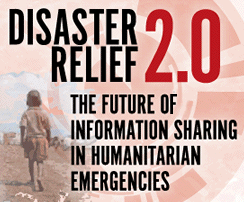Ed note: The report Disaster Relief 2.0: The Future of Information Sharing in Humanitarian Emergencies analyzes how the humanitarian community and the emerging volunteer and technical communities worked together in the aftermath of the 2010 earthquake in Haiti, and recommends ways to improve coordination between these two groups in future emergencies. The UN Office for the Coordination of Humanitarian Affairs (OCHA), together with the United Nations Foundation and Vodafone Foundation Technology Partnership, commissioned the report, which was researched and written by a team at the Harvard Humanitarian Initiative.
The Disaster Relief 2.0 Blog Series provides a public forum for people from both the humanitarian and volunteer and technical communities to discuss ideas in this report and the future of disaster relief.
You can follow conversations about the report on Twitter using the hashtag #DisasterTech and on the UN Foundation’s Facebook page.
Disaster Relief 2.0: “Better Things”
By Jonathan Robertshaw
The Disaster Relief 2.0 report was met with some heated reactions, but whether positive or mixed there’s no denying they contribute to starting the debate the authors saw as the crucial next step.
The report raised a range of issues that cover managing existing information as well as the new information sourced from the population itself. I confess to a techie they are intriguing problems, but they aren’t unique or new. They have been solved both well and badly outside the relief sphere and the skills are out there in many forms. While they need to be resolved it is important that debate that has been started doesn’t limit itself to this alone.
What was new was the scale of the communication undertaken with the community. This is more than just a source of information. Opening paths of communication empowers communities affected by disasters. Early information enables them to respond themselves, ongoing information can remove barriers to effective aid and two way communication means a continuous input on the needs and on the programming from the people with the biggest stake.
In Haiti circumstance meant the population had the tools to communicate, media interest and the web meant they would be heard somewhere, the entry of new tech groups helped them to be heard in the relief community itself. It won’t play out like that every time, the channels may be harder, the existing communications less publicised. But the fundamental value of those communications is universal.
So unless information needs are going to be picked up only where it’s easy or only by small specialist groups, the conversation has to be not just about the details but about engaging the mainstream agencies – as a few projects have begun to do. Information issues will arise but so will bigger process issues. Crack the problem of getting the information clear and you come up immediately against what you can do with it. Continuous dynamic input from the community is only truly valued, and valuable, if the responders have the structures that allow them to amend, improve and even drop programming in response.
The technology issues will continue to evolve and, if they are seen as important, get fixed. We need to hear from agencies who have to decide if they will plan to communicate, and from donors who have to decide what to fund and measure. We have to see this as an opportunity not just to do things better but to do better things.
Jonathan Robertshaw works for the BBC as a media technologist, and for the BBC World Service Trust / Internews project “Infoasaid” working with agencies to improve beneficiary communication through new technologies.
